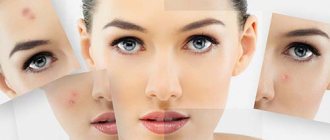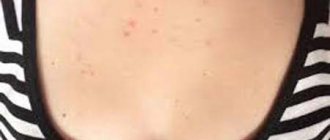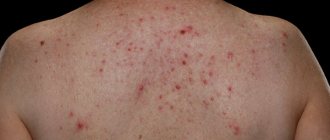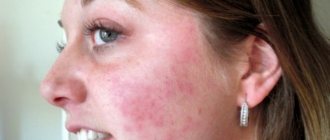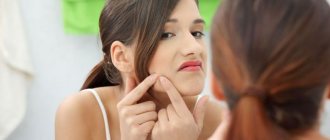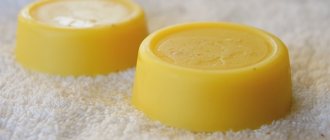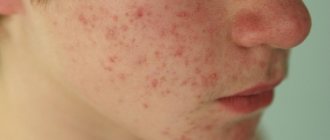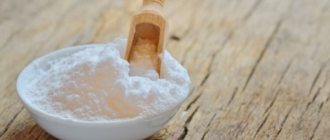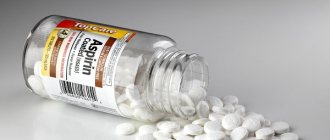Uncle Robert Yurievich
Venereologist, Dermatologist, Cosmetologist, Therapist
Doctor of the highest category, Candidate of Medical Sciences
Back acne is a problem that affects every person. Besides the fact that this is not a pleasant or beautiful phenomenon, they often leave traces in the form of dark red spots or scars.
There are two ways to get rid of it:
- Treatment in a beauty salon or clinic where similar procedures are performed.
- Folk remedies at home.
But in addition to treatment, drinking regimen and proper nutrition play a significant role in getting rid of acne marks. For better cell regeneration, you need to drink at least one and a half liters of fluid a day and eat more vitamins and fiber.
Reasons for appearance
Those who have undergone a cleaning procedure with a professional cosmetologist know that high-quality work does not leave any traces behind, and if there are any, they go away very quickly. Why doesn't everything always go as smoothly?
The spots are accumulations of melanin in damaged cells due to the inflammatory process. Melanin is a pigment that colors human skin and hair and is also responsible for protection from sunlight.
The more intense the color of the marks, the more serious the damage, and accordingly, to remove bluish stains you will need more effective methods than to get rid of pink ones.
The darkening of lesions is facilitated by:
- exposure to sunlight;
- rough mechanical cleaning (squeezing);
- failure to comply with asepsis rules;
- incorrect treatment with alcohol or other solutions;
- untreated inflammatory process;
- diseases of the gastrointestinal tract, in particular the biliary system;
- hormonal imbalance.
Pigment lightening is facilitated by 2 physiological processes:
- Increased blood circulation, which will enhance metabolism in the hearth.
- Exfoliation of the stratum corneum of the epidermis, which will stimulate skin renewal.
It's time to consider all possible options to help these two processes rid the skin of defects.
What can you do at home?
You can start your journey to perfect skin without leaving home. If the spots have recently appeared, daily self-treatment will be especially effective.
The use of folk remedies
- Fruits and vegetables: in professional peelings it is very popular to use fruit acids, which have proven themselves to be excellent components in the fight against pigmentation.
- Lemon. You need to mix the juice and water in equal proportions 1:1, apply this mixture with a cotton pad, rinse after 15-20 minutes, and moisturize the skin with cream.
- Apple vinegar. You need to dilute it with water in a ratio of 1:3, wipe with a cotton pad twice a day.
- Cucumber. You just have to cut the unpeeled vegetable into several circles and spread it all over your face. Leave for 20-30 minutes. There is no need to rinse off the cucumber juice.
There are also several good masks using fruits and vegetables:
- 2 tsp lemon juice + egg white, mix, apply to face for 15 minutes, rinse, moisturize;
- 5 banana pulp + egg white, mix, apply for 20-25 minutes, rinse;
- 1 tbsp. tomato pulp + 1 tsp. starch, mix, apply for 15-20 minutes, rinse, moisturize.
Masks need to be done 2 times a week.
- Parsley. Chop half a bunch (40 grams), add a glass of water, boil for 5 minutes, cool and wipe your face with the broth several times a day. You can also freeze it in molds and wipe your face with ice.
- Clay: It is a base component of many masks and has versatility in solving many skin problems. To whiten pigmentation after inflammation, mainly white and green clays are used.
- 1 tbsp. white clay + 2 tbsp. lemon juice + a little water, add water gradually until a creamy consistency is obtained, cover the lesions, rinse after 15-20 minutes;
- 3 tbsp. green clay + 1 tsp. olive oil + 1 egg white + 1 tbsp. mashed kiwi or banana pulp, apply for 15-20 minutes, rinse.
Clay masks should also be used 2 times a week.
- Essential oils: they are a highly concentrated storehouse of beneficial microelements and are very popular in cosmetics. However, it should be remembered that esters can also be strong allergens, so before using them, you need to do a test on the forearm. Pregnant women should avoid this ingredient.
- 2 tbsp. clay + 4 drops of rosemary oil + 50 ml of water, bring to a homogeneous consistency, apply for 15-20 minutes;
- tea tree oil + lemon juice in a 1:1 ratio, wipe your face;
- 2 k rosemary oil + 1 k mint oil + 1 k lavender oil + 1 k clove oil + 1 tbsp. olive oil, dilute, apply to defects several times a day;
- Mix 5 parts of lavender, neroli and frankincense oils and apply to spots several times a day.
If a rash, itching or other signs of irritation occur, stop using essential oils and consult an allergist or dermatologist for advice.
- Other, but no less effective means:
- Aloe. You need to wipe your face with its juice several times a day, do not rinse it off.
- Honey and ground cinnamon. Mix them in a ratio of 1:1 and apply to the stains for 25-30 minutes, rinse with chamomile decoction or water. Cannot be used for rosacea.
- Paraffin. Do a skin test for irritation first. Melt a small amount of cosmetic paraffin in a water bath, cool slightly and apply to spots. Before the procedure, lubricate your face with a light nourishing cream. Once hardened, remove.
Read a review of Garnier's acne and blackhead remedy. How to get rid of acne in a week for a teenager? The answer is in this article.
Use of pharmaceuticals
Today, pharmaceuticals offer a large selection of products for the treatment of post-acne. Before using this or that drug, you can consult with a cosmetologist to choose the most optimal solution.
- Badyaga. This is a powder of a dried freshwater sponge, which has a strong irritating effect due to which it increases blood circulation. It is better to apply masks before going to bed once a week, so that by the morning the redness will disappear.
It is necessary to dilute a small amount of powder with water or 3% hydrogen peroxide to a mushy state and apply pointwise to the stains for 5 minutes, rinse.
You need to be very careful with badyaga, as it can cause burns. It is better to use it to remove spots on the body.
- Zinc ointment. An affordable and effective method that effectively reduces redness. Apply to face 1-2 times a day.
- Syntomycin ointment. It has antibacterial properties, so it will cope with acne without leaving marks.
- Tincture of calendula or St. John's wort. Sold in many pharmacies. You need to wipe your face several times a day.
- Clearvin. A cream based on natural ingredients that solves several skin problems at once. Apply a thin layer to the skin 2 times a day.
- Sledocid. The name speaks for itself; the main goal of the product is to get rid of even old traces of acne. It has both antibacterial and moisturizing effects.
- Contractubex. Gel-ointment for fighting scars, but also effectively resolves stagnant spots. Use 2-3 times a day for a month.
- Heparin ointment. Perfect for removing fresh stains. It is necessary to apply a thin layer to the lesions and then rub in well.
Salon treatments to get rid of acne spots
Post-acne can manifest itself in the form of skin pigmentation or scars. Scars remain due to severe inflammation. Both blemishes and scars usually bother those who like to squeeze and pick pimples. Moreover, if you can get rid of stains on your own, then if there are scars, you need to contact a specialist.
What treatment methods are used in beauty salons? The most popular of them:
- Chemical or ultrasonic peeling. Quite effective methods of getting rid of the consequences of acne. There is an unpleasant side to this procedure – thinning of the skin.
- Algae masks are an effective method, but require long-term use.
- Microcurrent therapy. Microcurrents used in this procedure accelerate skin renewal and regeneration, and also normalize the functioning of the sebaceous glands.
- Fraxel or fractional photothermolysis. A laser procedure that is becoming increasingly popular. Can be used on any part of the body.
- Cryotherapy, in other words, cryomassage. Used to remove scars. Based on the effect of liquid nitrogen on the skin.
- Laser resurfacing. The method is the most effective, but expensive in eliminating the consequences of acne. The procedure is considered a surgical operation and should only be performed by qualified specialists.
- Mesotherapy. The essence of the procedure is injections, which contain various substances and vitamins. To treat post-acne, compounds containing zinc are usually used.
After any salon procedure, careful skin care is required. Cosmetologists will tell you how to do this correctly. If your skin does not have deep scars, try eliminating post-acne at home before going to the salon.
How to remove acne spots in a cosmetologist's office
The most effective methods are still professional cosmetic procedures. Depending on the depth of the lesion and the accompanying characteristics of the skin, the doctor will select the necessary method or a combination of them.
These include:
- Peels. Fruit acids such as glycolic, lactic, and malic are most often used. For more serious skin defects, TCA peels are used. They promote rapid exfoliation and cell renewal.
- Dermabrasion. Mechanical exfoliation of the stratum corneum of the epidermis, which also promotes skin regeneration. The procedure is very unpleasant, but effective, especially for aging skin with a lot of post-acne.
- Laser resurfacing. Recommended for removing old marks, it is highly effective, but very painful and several procedures are required to achieve results in advanced conditions.
- Photothermolysis. The procedure heals and renews the epidermis by stimulating microcirculation.
- Microcurrent therapy. Scars and blemishes are reduced by increasing the production of collagen and elastin.
- Mesotherapy. Injections of collagen, low-percentage acid solutions and other drugs are administered to a depth of no more than 3 mm, which stimulates metabolic processes in the skin.
- Ozone therapy. Intradermal injections of an ozone-oxygen complex, which reduces inflammatory processes and leads to skin healing.
Types of skin rashes
There are several types of acne that can appear on the back:
- blackheads, or open comedones, which are formed when the mouth of the hair follicle is blocked by sebum,
- papules, or pinkish bumps on the skin,
- closed comedones, or whiteheads, they appear due to the accumulation of subcutaneous fat in the hair follicle, which cannot come out,
- pimples, or pustules, pustules are papules on the skin filled with pus. Usually there is an inflammatory process around them, expressed by redness of the skin,
- internal pimples, which form deep under the skin and can become hard, forming large bumps that are painful
- Cystic acne occurs as a result of sebum clogging the inside of the follicle. This is a severe and painful form of acne, and as it heals, it leaves marks, scars, and scars on the skin.
Makeup as a method of correction
It should be noted that masking a problem is not its solution. Along with the treatment of acne and post-acne, in special cases, without abuse, it is possible to hide defects. Regular use of makeup will only make the situation worse.
So, how to correctly correct your facial tone:
- Prepare the skin for applying makeup: wash with soft foam and then wipe your face with toner.
- Apply makeup base. It will even out the surface of the skin and subsequent products will be better distributed over the face.
- Use corrector precisely. Green is suitable for masking red marks. Then cover the skin with foundation or BB cream.
- Apply powder over the T-zone and blush on the cheekbones.
All of the above cosmetics should be selected taking into account your skin type. It is advisable to choose hypoallergenic and non-comedogenic formulations.
Difficulties in healing skin
Photo: the appearance of pigmentation after acne
Anyone who has ever tried to get rid of back acne has quickly encountered two problems:
- It is very difficult to cure rashes in this area;
- Despite proper treatment, acne marks may well remain.
Both treatment difficulties are associated with the peculiarities of both the site itself and the skin on it:
- the skin on the back is thicker than on the face, so acne is usually located deeper, which leads to the appearance of marks (post-acne);
- if the problem on the face can be solved with the help of masks and compresses, then on the back it is more difficult to do this, since it is constantly in contact with either clothes or hair;
- Some products (ointments, creams, masks, scrubs) cannot be applied to the upper back on your own.
Due to these difficulties, acne can progress; in this situation, acne marks often form on the back, which are as difficult to remove as the rash itself.
Prevention of occurrence
- do not get carried away with squeezing out ulcers and inflammations;
- if this does happen, treat the outbreak with a disinfectant solution without alcohol (hydrogen peroxide, chlorhexidine);
- instead of mechanically acting on pimples, it is better to dry them with salicylic acid until they dry into a crust and fall off, but not more than 3 times a day;
- choose the right cleansers and use them morning and evening to prevent inflammation;
- maintaining a healthy lifestyle: physical activity, proper nutrition and giving up bad habits;
- protection from UV rays using creams or gels.
See how to get rid of acne in 1 day using aspirin. Where can I find reviews of home remedies for acne? Details here.
How to get rid of acne at home? Read on.
Traditional methods
Traditional medicine also knows recipes with which you can fight post-acne.
- St. John's wort tincture is good for stains. Pour 15 grams of dry raw material into a glass of vodka and leave for 3-5 days in the dark. Apply directly to stains at night.
- Dilute apple cider vinegar with 3 parts water and apply the solution to stains or scars overnight.
- Pour a bunch of fresh parsley into a glass of water and boil for 2-3 minutes. Freeze the resulting broth in the form of cubes. Rub your back with the cube every morning and evening. Parsley lightens the skin and promotes its regeneration, and ice activates blood circulation.
Photo: lemon juice brightens the skin and makes spots invisible
- Dilute lemon juice in half with water and apply with a cotton pad to acne spots 2-3 times a day.

